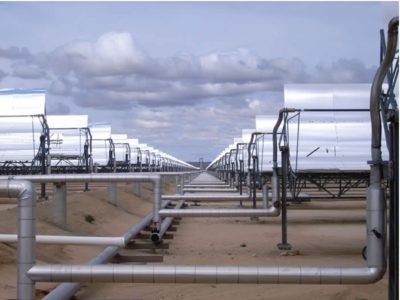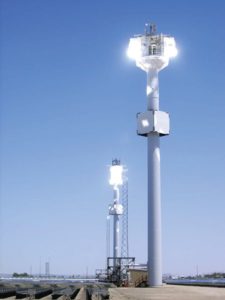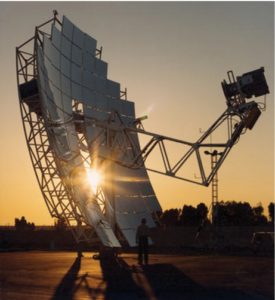Concentrated solar power (CSP), also known as concentrating solar power, solar thermal power, or solar thermal electricity, uses glass mirrors of different architectures to collect the sun’s thermal energy and convert it into electrical energy. This is achieved via conventional thermodynamic power cycles that are adjusted to the specific needs of solar power generation.
Instead of providing thermal energy via burning fossil fuels (which causes vast CO2 emissions and air pollution) or via nuclear reactions, the naturally and freely available solar irradiation is used to increase the working fluid’s enthalpy, which finally drives a steam turbine. The turbine is connected to the shaft of an electrical generator in order to generate electricity and the power produced is then fed into the grid.
The main technologies that can be found on the market are steam based, engine based, and PV based. In most cases, water/steam is used as working fluid (Rankine steam cycles), but there do exist some concepts that are still under consideration in which air or CO2 is used as working fluid, which drives a gas turbine (Brayton gas turbine cycle). This last design enables the possibility to run an attached bottoming steam cycle and by using heat recovery boilers results in the so-called solar thermal combined cycle plant.
In addition, typical Sterling engines are non-steam-based technologies, and they are used to convert solar thermal energy into mechanical work.
Concentrated Solar Power plants have the inherent energy storage capability in the form of heat, and with further support from additional thermal storage systems or a hybrid system, Concentrated solar power plants may continue to generate electricity even when clouds block the sun rays.
Although Concentrated Solar Power has better performance for grid integration than other renewable energy options, the relatively immature technology and the high cost restrict its large-scale deployment.
In addition, one disadvantage of Concentrated Solar Power is that it requires strong direct sunlight. Consequently, the highest share of CSP resources is mostly limited to semiarid, hot regions or deserts. However, similar to other thermal power generation plants, CSP requires water for cooling, which constitutes a big challenge in exploiting Concentrated Solar Power resources in arid regions.
1.1 Solar Thermal Power Concepts
Solar thermal power plant concepts can be divided into two basic categories, namely, line and point focusing technologies.
On one hand, line focusing systems concentrate the incident solar direct irradiation onto a focal line, in particular onto solar receiver tubes that are placed all around the focal lines of the solar collectors.
On the other hand, point focusing systems concentrate the incoming solar irradiation onto a single focal point or better, onto a focal area that is very small compared to the total size of the reflecting mirror surface. One single solar receiver is therefore placed at this focal point or area.
Generally speaking, the concentration of the incoming solar irradiation is the fundamental principle in order to reach high temperatures, thus providing high-quality thermal power that enables the operation of conventional thermodynamic power cycles. In this sense, the Concentrated Solar Power is not based on the PV effect anymore.
Nowadays, the most used design is the parabolic trough collector technology (line focusing). There, the power cycle’s working fluid is heated indirectly, using a heat transfer fluid that is heated within the focal lines of the parabolic troughs. Temperatures reached a range between 400 °C and 550 °C, depending on the used heat transfer fluid (thermal oil or molten salts).
Another concept that has been tested and operated successfully is the solar power tower or central receiver concept (point focusing). In that case, the solar radiation is concentrated onto a central receiver area, which is placed at the top of a tower, using many slightly curved mirror elements. At the receiver, the concentrated solar energy is transferred to the working fluid or heat transfer fluid. Depending on the concept, temperature levels can exceed 1000 °C. Power towers promise high efficiency if used with Brayton cycles, as they can be extended to solar-combined cycle plants.
Additional concepts are the linear Fresnel collector concept (line focusing) and the parabolic dish collector concept (point focusing).
The linear Fresnel concept is similar to the parabolic trough systems, also line focusing. In this architecture, many flat mirror elements concentrate solar radiation onto a horizontal receiver tube.
Parabolic dish collectors concentrate the sunlight onto the focal point, where Sterling engines transform the thermal energy into electrical energy. They provide good efficiency rates in small power classes, ideal for isolated and stand-alone applications. The most characteristic Concentrated Solar Power designs are briefly described in the following:
1.1.1 Parabolic Trough
The focal point in solar parabolic linear reflectors can be found along their length (see Figure 1). A receiver pipe with a fluid (oil or molten salt) is running along the inner part of the curved surface.
The concentrated solar energy heats the fluid flowing through the pipe, and the heat energy is then used to generate electricity in a conventional steam generator. Trough designs can incorporate thermal storage allowing for electricity generation during the evening.
FIGURE 1 Parabolic trough line concentrator for Concentrated Solar Power.
1.1.2 Linear Fresnel Reflector
This kind of technology approaches the parabolic trough collectors but uses an array of flat or slightly curved mirrors to collect the sun rays onto a fixed receiver mounted on a linear tower (see Figure 2).
The linear Fresnel reflector (LFR) field can be pictured as a broken-up parabolic trough reflector, but it needs less land to generate a specific output. Its major asset is that it uses flat or elastically curved reflectors, which are cheaper compared to parabolic glass reflectors.
However, LFRs are less efficient than troughs in converting solar energy to electricity and it is more difficult to incorporate storage capacity into their design.
FIGURE 2 Scheme of a linear Fresnel solar collector.
1.1.3 Solar Towers
Solar towers (see Figure 3), also known as central receiver systems, utilize hundreds or thousands of small reflectors (called heliostats) to collect the sunlight on a central receiver mounted on the top of a fixed tower. The working fluid (mostly sea water) is heated and later drives a turbine to produce electrical power.
In this design, very high temperatures are reached; therefore, an increase in efficiency is marked resulting in less cost of thermal storage. Temperatures reached in a solar power tower can be greater than 1000 °C.
FIGURE 3 Central solar tower receiver.
1.1.4 Parabolic Dish Reflector
This topology consists of a stand-alone parabolic dish, as shown in Figure 4. The parabolic dish collects the sun rays and converts solar radiation into thermal energy in a running fluid. The thermal energy can then either be converted into electricity using an engine genset coupled directly to the receiver or be transported through pipes to a central power-conversion system.
The Sterling machine is the most frequent type of heat engine used in parabolic dish systems that can reach temperatures more than 1500 °C.
FIGURE 4 Schematic view of a parabolic dish solar system.
The pressure of the steam fluid drives a generator to produce electrical energy and for a large Sterling power plant, a lot of these dishes are connected to attain megawatts of electrical power.
The greatest advantage of dishes is their high efficiency at thermal-energy absorption and thus the highest solar-to-electric conversion performance of any Concentrated Solar Power system. However, the need for a heat transfer fluid throughout the collector field raises design issues, such as piping layout, pumping requirements, safety, and thermal losses.



